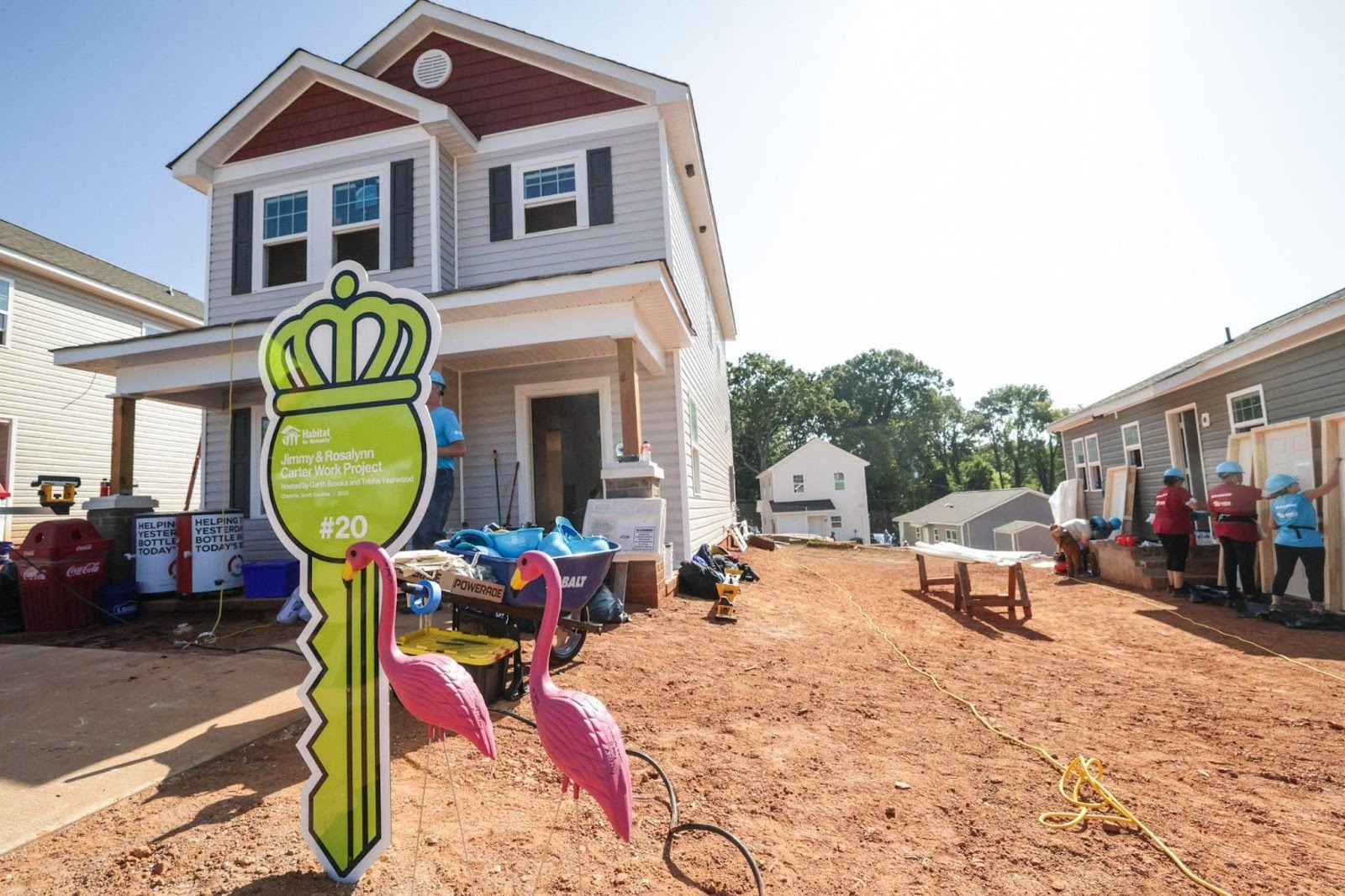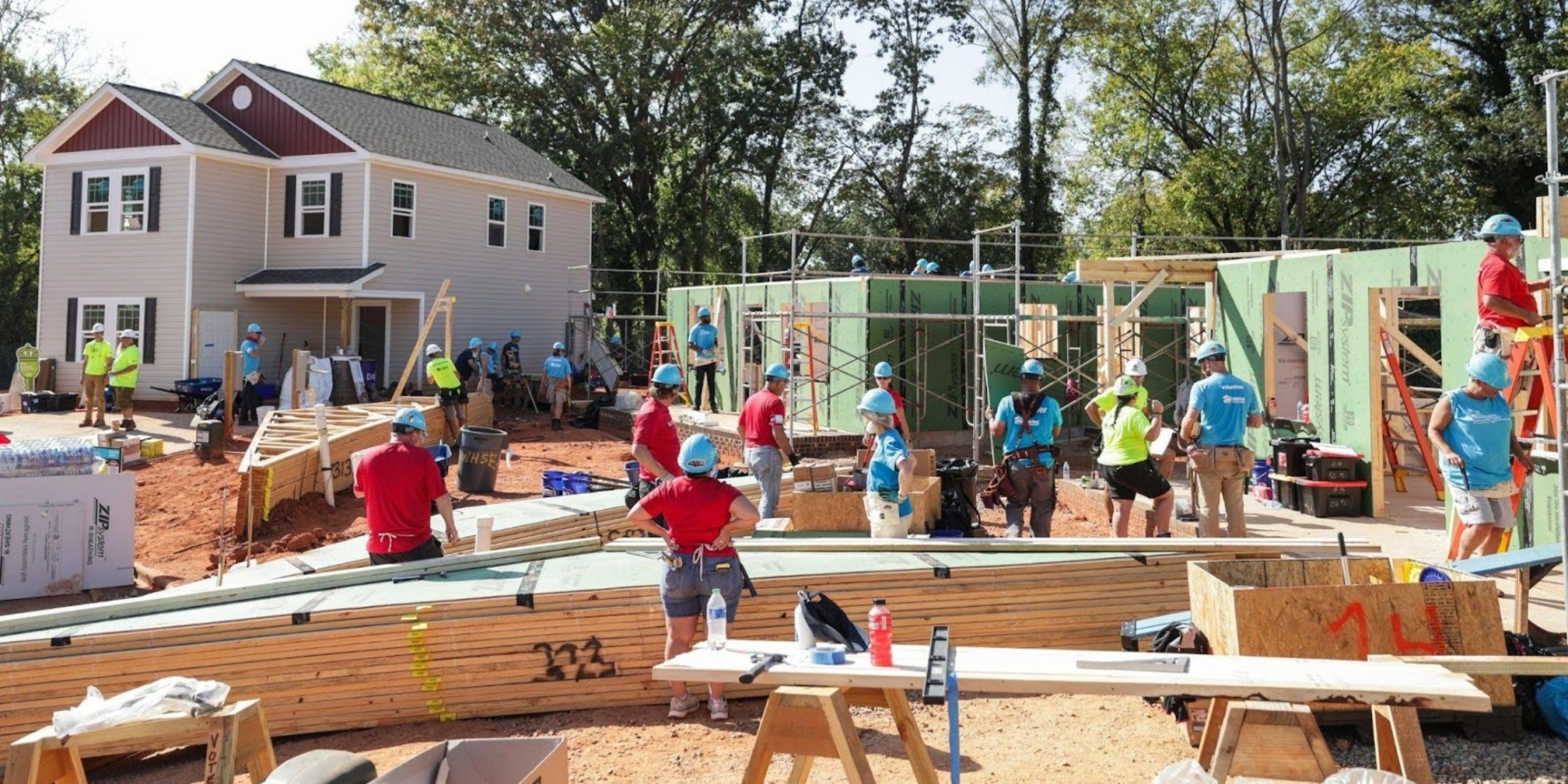by Lisa Vernon-Sparks, The Charlotte Observer
Videos by Lexi Wilson, WCNC Charlotte
Ruby Little remembers when she began noticing shifts in her community: the new construction, the light rail running, the park being cleaned up.
From her modest Habitat for Humanity-built home on North Caldwell Street, the 67-year-old has watched her neighborhood evolve from working class to one that has become more gentrified — and more expensive.
“Overall, I like it better. You can’t stop it. People knew it was going to evolve and change,” Little said, referring to policymakers. But as for her and her neighbors, she added, “We just didn’t know.”
Just outside uptown Charlotte, the neighborhood was among the earliest projects by the Habitat Charlotte Region office that opened in 1983. While the affiliate mainly built homes in west Charlotte, in 1987 it hosted a Carter Work Project in Optimist Park. There 350 volunteers, including former President Jimmy Carter and the late First Lady Rosalynn Carter, built 14 homes in five days.
Those Optimist Park Habitat homes did not have deed restrictions on what were often 15- and 20-year mortgages. That meant a Habitat home purchased for an average of $35,000 can be sold for market rate at any time. Some Habitat homes that were set aside as affordable some 40 years ago have been resold by owners at market price — some upward of $300,000 — staggeringly higher than their initial price.
That certainly benefited the homeowner, but it has made it difficult to keep the neighborhood affordable for future residents. In response, Habitat in 1992 began adding various restrictions and other clauses to its deeds.
Such restrictions are now placed on all new homes, most of which are 30-year mortgages. The restriction gives Habitat the first right to purchase the home if a homeowner wants to sell it, CEO Laura Belcher told the Charlotte Observer in an email. In 2016, Habitat added a clause that allows it to collect some of the appreciation if it’s sold before the 30-year mortgage is paid.
That hasn’t happened much yet, Habitat says, because it’s a relatively new policy and Habitat homeowners tend to stay in their homes for a long time.
The owner must occupy the home and have no renters for Habitat to purchase it. When Habitat repurchases the home, it makes light repairs then resells the house to another Habitat income-qualified family — below 80% of area median income, keeping the home and neighborhood affordable.
“The current tools protecting long-term affordability were not in place when Optimist Park was built in 1987,” Belcher said. “We have modified and adjusted our affordability clauses and deed restrictions to preserve more long-term affordability.”
Consider Frank DuPont’s home on Julia Maulden Place, built during the 1987 project. He sold it in 2022 for just under $300,000 and made a hefty profit on the $35,000 he paid for it. The home is appraised for more than $366,000, according to the Mecklenburg County assessor’s office records.
DuPont, 71, said selling the home had its pros and cons. He bought another house with cash and paid some debts.
“Why would I want to move?” DuPont said, while recalling how he loved being close to uptown. “I could be at my church in about six minutes, right on the corner of Davidson and Ninth Street. I can walk to work, walk to my church, walk downtown, walk anywhere I want. I had no reason to move.”
But DuPont felt with new people moving in with larger homes and planning a neighborhood association with new rules on how the front of a home should look, Optimist Park was no longer for him.
Ruby Little says she has no plans to move and hopes to pass wealth to her children when they inherit the home. Other former Habitat homes, including two on Julia Maulden Place and a few along North Caldwell Street, have been sold and replaced with bigger, more expensive homes, townhomes or duplexes.
One home, at 1608 Julia Maulden Place, sold to a family in 1989 for $38,400, according to county deed records. The county records show the family sold the property in 2020 to an investor. The home was razed in 2021 and at the time had an assessed value of $130,500. A new three-story townhome has been built on that same plot and sold in 2022 for $1.3 million, according to the county assessor’s records.
Charlotte Habitat has built some 1,500 homes since 1983. While the vast majority have deed restrictions, it is difficult to say how many have which provisions because the deed restrictions evolved over time, Belcher said.
Belcher added the longer a Habitat homeowner stays in their home, the greater share of the appreciation they can keep.
In October, a new generation of families began logging sweat equity in another part of the city as Habitat resumed construction on another major build — The Meadows at Plato Price. The site — where a former segregation-era school of the same name stood until 1966 — was vacant until the 1980s when the city took it over, later donating it to Habitat.

More than 3,000 volunteers built 27 homes for the 2023 Jimmy & Rosalynn Carter Work Project in the Meadows at Plato Price development the week of Monday, October 2, 2023 in Charlotte, NC. Photo: Melissa Melvin-Rodriguez/Charlotte Observer Staff Photographer
Kee’a Carroll, a single mother with two teenage girls, was among those helping with the build. After living in an apartment for a decade, Carroll expects to move into a permanent home early next year.
The Observer spoke with Carroll, Little and her daughter Rachel, and DuPont about their experiences with Habitat-built homes.
Growing up Habitat
Rachel Little remembers the positives and negatives growing up in Optimist Park during the late 1980s. Her parents Ruby and Jimmy Little purchased a home in 1988 on North Caldwell with the help of the Habitat program and subsidies for $32,500, according to Mecklenburg County deed records.
The area was a former mill community, but it was close to uptown.
“It was beautiful where they built right in the city. I know then they couldn’t have (known) what it would be now but, it pretty much urbanized the area,” the 37-year-old told the Charlotte Observer. “We were the first set of houses. It kind of set the tone for the area, to be honest.”
Because it was a Habitat community, families were sponsored by churches and other programs, Rachel Little said, noting she remembered being invited to a summer camp and other things.
On one side of her parents’ home, there was a warehouse. Big 18-wheeler trucks used to come in and out of the neighborhood. On the other side, nothing but open land. Across from the home was a set of high-rises and four other homes in front of them.
A variety of nationalities — Cambodians, Vietnamese and others — lived across the street from her parents, she said.
“It was a mixed environment, but around us, it was predominantly white,” Rachel Little said. “We were like the group of Black people, the Black families, so to say.”

Rachel Little sits outside her mother’s Habitat for Humanity-built home on Thursday, November 2, 2023. On her street only a few homes built during the Carter project in 1987 are still occupied by the original owner. Photo: Melissa Melvin-Rodriguez/Charlotte Observer Staff Photographer
Having Habitat created stability, Rachel Little said. She has worked an assortment of jobs, from school teacher to truck driver.
“The vibe of the community was awesome,” says Mark Davis, 60, who volunteered at a local Episcopalian church to help Habitat families during the 1990s. “We used to walk around, from house to house, visiting people. We knew just about everybody on each block. It was awesome. Obviously, that has just changed.”
Little recently moved back home to take better care of her mother, who is ailing. The second-generation homeowner says she’s not phased by the rapid development happening around her beloved neighborhood and doesn’t see it as gentrification. Habitat has always been there for her family and Mecklenburg County and the state help with tax relief programs to offset rising property values.
“My parents and I feel like Habitat was just like the stepping stone … that keeps on stepping, honestly,” she said. “It’s not what happens, it’s what you do after it’s happened. I’m grateful that some of these areas are finally getting lifted up.”
‘I was speechless’
After Frank DuPont moved into his Habitat home in 1987, he would spend many weekends working in his front yard. One time while puttering with a leaf blower, he saw two black cars circling the cul-de-sac near his corner lot at 19th Street and Julia Maulden Place.
He remembered not knowing anyone with those sleek cars — the kind he’d seen in a motorcade. Must be going to another home, he mused. But the cars pulled up in front of him.
A driver came out and strolled around to open the back passenger side door.
“And Rosalynn Carter (came) out. She started walking down the sidewalk,” DuPont recalled. “I knew her face, and I had to think for a minute: This is the President’s wife coming to visit me?”
It was one of several great moments DuPont and his wife, Diane, experienced while being Habitat homeowners.
The happy encounter with the late First Lady was not his first meeting with her. When the Carters came to build homes in 1987, the DuPonts and others worked alongside the couple, building the homes and their future. This time, the First Lady simply was checking in.
“She said she was just stopping by and, ‘how’s the house coming along?’ and if I needed anything. I was speechless,” he said.
DuPont said he really appreciated Habitat giving a young couple “hope“ — especially since they had very little credit history, he said.
DuPont continued to help build homes for Habitat for the next 13 years, working as a site manager for the nonprofit.
Selling his home helped him financially, but it “absolutely” was not something he was planning to do.
He says Habitat could be more involved in the lives of homeowners after they purchase homes and check in on them, like Rosalynn Carter did. Perhaps the nonprofit could find a way to preserve the community as a Habitat neighborhood forever, so when new families move in, it’s still affordable, he said.
“If man can send this spaceship up there,” he said, referring to when he watched a NASA mission on television, “surely man can figure out a way to save (the) Habitat for Humanity neighborhood. Put the effort into it.”
“What we are doing today aids in keeping homes affordable longer than when we began,” Belcher said in an email.

Kee’a Carroll, center, stands outside her new home with her daughters Nee’a Tucker, 15, left, and Lee’a Tucker, 14, on Thursday, November 2, 2023. The home was built during a 27-home Carter build that began in October. Carroll, among a new generation of Habitat For Humanity homeowners, will be moving her family into the house in the beginning of next year. Photo: Melissa Melvin-Rodriguez/Charlotte Observer Staff Photographer
’I’ve survived worse’
It was denial number three for Kee’a Carroll when her Habitat for Humanity application for a home was rejected last year. With her teenage daughters growing, plus juggling jobs and school, it was uncomfortable, again.
But Carroll was used to being uncomfortable.
Growing up in New York City, she never had a permanent home as her family moved around. She attended four high schools. She steered clear from ever making new friends, knowing she would be at a different school come the next fall.
As an adult, Carroll was running from an abusive relationship when she arrived in Charlotte more than a decade ago. She stayed at a relative’s home. She worked two jobs and hustled to handle everything.
“We slept on a mattress,” that had no frame and was on the floor, she said.
A chance meeting with a neighbor led to connections with Charlotte Family Housing and the apartment she has lived in since 2012. But it was getting harder to manage things, with her daughters, now 14 and 15, needing more space.
Determined to persevere, Carroll, 39, finally is seeing some success. She received notice earlier this year that Habitat approved her application and now is among dozens of families getting new Habitat homes at The Meadows at Plato Price.
“I’ve been working so hard and as a single mother, it’s a struggle every day, to just get up and do the things that you need to do for your children, for yourself,” she said. “To actually have been accepted, I was like wow, if I just don’t give up, that’s it. I come from a strong mother, a strong line of women. And I’m not gonna let it beat me. I’ve survived worse.”
Carroll has been logging sweat equity hours for the better part of a year to earn a plot. Besides the hours to help build the home, Carroll will also do volunteer hours at Habitat’s ReStore shop.
“The resource is really nice because to me it’s (an) upscale Goodwill, in a sense,” Carroll told the Charlotte Observer. “People come in there and they bring furniture and they bring different stuff there, and you just go in and you help set the stuff up. You help customers and stuff, which is pretty simple.”
Finding the three or four hours a week to do that was the greatest challenge. Because she is getting a brand new home, Carroll needed to earn at least 300 hours.
“For me it really didn’t matter, if it was refurbished or if it was brand new, I really didn’t care,” she said. “I just wanted a home.“
This story is part of ‘I Can’t Afford to Live Here,’ a collaborative reporting project focused on solutions to the affordable housing crisis in Charlotte.
The Charlotte Observer is part of the Charlotte Journalism Collaborative (CJC), launched by the Solutions Journalism Network with funding from the Knight Foundation. The CJC strengthens the local news ecosystem and increases opportunities for engagement. It is supported by a combination of local and national grants and sponsorships. For more information, visit charlottejournalism.org.




